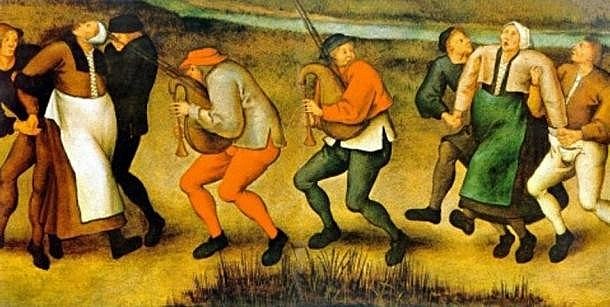Top 6 Bizarre Mass Hysteria Events That Shocked the World
♦ Fact-Check: Top 15 Mysteries Behind the Famous Artworks of All Tim
♦ Top 13 Most Creepy And Mysterious Mysteries That Have Finally Been Explained
What Is Mass Hysteria? The Bizarre Psychological Phenomenon That Spreads Like a Virus
Mass hysteria—also known as mass sociogenic illness—is a psychological phenomenon where groups of people suddenly develop physical or emotional symptoms without any identifiable medical cause. “Think of it like a placebo effect gone wrong,” says Dr. Robert Bartholomew, a psychological medicine expert from the University of Auckland.
Though often misunderstood, hysteria is a real neurological and psychological condition. It typically stems from extreme anxiety or unresolved inner conflict, leading to emotional outbursts, fainting, muscle weakness, or even uncontrollable laughter.
Mass hysteria can affect both men and women, but it's most common among girls and young women aged 14 to 25. Globally, about 3 to 5 in every 1,000 people may experience some form of hysteria.
What makes mass hysteria so shocking is how fast it spreads—sometimes sweeping through classrooms, workplaces, or entire communities within days. No virus, no toxin—just shared belief, fear, and the powerful influence of the human mind. These cases have baffled scientists for centuries and continue to challenge our understanding of psychology.
 |
| Cases of Mass Hysteria Through History |
Here are six mass hysterias that are said to be the most mysterious in human history:
1. The Dancing Plague of 1518: When Hundreds Couldn't Stop Dancing—Literally
It all started on a sweltering summer day in 1518, in Strasbourg, France. A woman named Frau Troffea suddenly began dancing in the streets—nonstop. She kept going for nearly a week. Within a month, more than 400 others had joined her, unable to stop moving. Some collapsed from exhaustion. Others died of strokes or heart attacks.
Witnesses described the dancers as if they were in a trance—possessed, even. Local authorities believed the cause was “hot blood” in the brain, a theory rooted in medieval medicine. In an attempt to “cure” the afflicted, officials made a fateful decision: they encouraged even more dancing. A stage was built. Musicians were hired. More dancers were brought in.
The result? Chaos. The dancing epidemic only worsened.
Historians still debate what caused this bizarre outbreak. One theory blames ergot—a hallucinogenic mold found on damp rye—that can trigger spasms and hallucinations. But that doesn’t explain how people kept dancing for days. Another theory points to collective stress: after years of plague, famine, and religious fear, a psychological release may have erupted into mass hysteria. Some locals believed they were cursed by a dancing saint—and that belief may have become dangerously contagious.
The so-called “dancing plague” didn’t stop in Strasbourg. Similar outbreaks were reported in parts of Germany, the Netherlands, and Switzerland. To this day, it remains one of history’s strangest mass hysteria events.
 |
| Dance mania, otherwise known as the Dancing Plague, St. John’s Dance, or the Dance of St. Vitus, gripped mainland Europe between the 13th and 17th centuries. |
The Biting Nuns (15 th Century)In the 15th century, another outbreak of mass hysteria occurred in Germany when a nun in a convent started biting the other sisters. Before long, the behavior spread throughout the convent and, as news spread further afield, so too did the phenomenon, resulting in biting outbreaks in convents across Germany, the Netherlands and Italy. As described by a 15th-century doctor: “ A nun in a German nunnery fell to biting all her companions. In the course of a short time, all the nuns of this convent began biting each other. The news of this infatuation among the nuns soon spread and it now passed convent to convent throughout a great part of Germany principally Saxony and It afterward visited the nunneries of Holland and at last, the nuns had biting mania even as far as Rome.” |
2. The "Writing Pandemic" of 1892
In 1892, the hands of some schoolgirls in Groß Tinz, Germany began to shake uncontrollably as they wrote. Some experience memory loss and altered consciousness. The following year, students in Basel, Switzerland began to experience a similar situation.
Dr Bartholomew said: “The hand tremors when writing in post-19th century Europe were a direct result of a new teaching method that treated the mind as a muscle that needed exercise. The tedious and repetitive exercises took a physical toll on the students. So the illness broke out as a subconscious way of trying to get out of the dreaded writing class.”
Salem Witch Trials (1692–1693)One of the most notorious instances of mass hysteria is that which occurred in Salem, Massachusetts, in 1692. Dozens of young girls displayed fits of uncontrollable screaming and contortions, which eventually triggered a flood of witchcraft accusations. The result was a series of hearings and prosecutions of people accused of witchcraft, known as the Salem Witch Trials, which resulted in the deaths of 25 citizens of Salem and nearby towns. The witch trials of Salem, which became a highly influential event in U.S. history, have been used in political rhetoric and popular literature to highlight the dangers of isolationism, religious extremism, false accusations, and breakdowns in due process. |
3. Matton gas poisoning, 1944
During the height of World War II paranoia, the town of Mattoon, Illinois was filled with rumors of a mysterious man spewing gas at random victims.
The first was Aline Kearney. According to her account, that day, there was "an unpleasant sweet smell in the bedroom" that "paralyzed my legs and lower body". When Kearney's husband got home from work, he saw a stranger outside their house. The Kearney family's story was published on the front page of the local newspaper, which claimed that a mysterious "anesthetist" was outlawed. Soon, the entire town was flooded with reports of similar incidents. News of the mysterious stalker caused a panic in the public for a while, but the attacker was never found.
4. Bug epidemic in June 1962
In June 1962, 60 workers in a textile factory in the US began to have strange symptoms: rash, nausea, and numbness. The media quickly picked up on the story, naming it the "June plague". According to the workers, an insect infected them with the plague. However, entomologists dispatched to the scene found no trace of the bugs.
 |
| In 1962 a mysterious disease broke out in a dressmaking department of a US textile factory. The symptoms included numbness, nausea, dizziness, and vomiting. Word of a bug in the factory that would bite its victims and develop the above symptoms quickly spread. Soon sixty two employees developed this mysterious illness, some of whom were hospitalized. |
Meanwhile, psychologists interviewed sick workers. The results showed that more than 90% of the victims worked the same shift, most worked overtime, and 50 of them only started reporting their symptoms after media coverage of the outbreak. . Since then, some have suggested that stress, along with the power of rumors, may be the cause of a large number of people finding themselves "sick".
5. “Laughing Translation” Tanganyika (Tanzania), 1962
In 1962, the country encountered a strange "epidemic" that forced them to close schools for weeks, when dozens of female students could not help but laugh. By the end of the outbreak, more than 1,000 people had been affected. Laughing is not the only problem, many other stressed students present with rashes, fainting and breathing problems. The official diagnosis given to this case was mass hysteria.
6. The Monkey-Man Panic of Delhi: Mass Hysteria or Urban Legend?
In May 2001, as a brutal heatwave swept through Delhi, India, frequent power outages forced residents to sleep on rooftops to escape the stifling indoor heat. That’s when the panic began.
Dozens of people—mostly men from working-class neighborhoods—reported being attacked by a strange creature described as half-man, half-monkey. Some claimed it had glowing red eyes, metallic claws, or even the ability to vanish. Panic spread fast. Victims arrived at hospitals with bizarre injuries, including scratches and bite marks. Two men tragically died—one fell off a rooftop, the other down a staircase—both reportedly trying to flee the mysterious attacker.
But when doctors examined the wounds, the truth became more disturbing. Many injuries appeared to be self-inflicted. Investigators found no physical evidence of a real creature.
So what triggered the chaos?
Experts believe the outbreak was fueled by mass hysteria, amplified by sensational media reports and wild rumors. Stories of demon possession, shape-shifting attackers, and "monkey-men" flooded TV screens and newspapers, sending fear through already anxious communities.
The 2001 Monkey-Man panic remains one of the most surreal examples of modern mass psychogenic illness—where fear spreads faster than fact, and belief becomes more powerful than reality.
Common Symptoms of HysteriaHysteria, or mass psychogenic illness, often begins with an otherwise healthy individual—typically a young woman—experiencing sudden spasms, tremors, or seizures following a psychological shock. While conscious, the person may scream, cry, or thrash about, seemingly without control. These reactions are often driven by a deep emotional need to be seen or acknowledged. The symptoms vary widely and may include:
A particularly concerning aspect of mass hysteria is its ability to spread. When one person faints, screams, or seizes, others—especially in high-stress environments like schools or factories—may unconsciously mimic the behavior. These "chain reactions" can result in dozens or even hundreds falling ill within hours. What Causes Mass Hysteria?Mass hysteria usually stems from:
It's not "faking it." These symptoms are very real to the people experiencing them. The human brain can react powerfully to fear, stress, and suggestion—sometimes more powerfully than to actual illness. Diagnosing and Treating Mass HysteriaBefore diagnosing hysteria, doctors must rule out other conditions with similar symptoms, such as:
Once physical illness is excluded, treatment focuses on psychological support:
A balanced diet, proper rest, and stress management techniques can reduce recurrence. The Social Stigma Around HysteriaDiagnoses of mass hysteria often spark backlash, with victims dismissed as "crazy" or accused of faking. But these episodes are not acts—they’re driven by belief. And belief is something every human shares. That means anyone, given the right conditions, can fall into the same psychological trap. |
 Top 11 Weirdest Airports Around the World Top 11 Weirdest Airports Around the World When we travel, we usually use the airports to get to the main sights. But sometimes an airport is SO WEIRD that it's the main ... |
 JUNE Calendar: Full List and Weirdest Holidays & Festival in the US and World JUNE Calendar: Full List and Weirdest Holidays & Festival in the US and World Check out the Top Bizarre, Unique Days and Special Holidays in the United States and Around the World on the Daily Calendar during the month ... |
 Top 10 Weirdest Buildings In Europe with the Bizarre Shapes Top 10 Weirdest Buildings In Europe with the Bizarre Shapes In Europe, a lot of buildings are well-known for their unusual shapes. See which ones are the most peculiar. |
 11 Most Bizarre New Year's Eve Traditions In The U.S. 11 Most Bizarre New Year's Eve Traditions In The U.S. Have you discovered how Americans celebrate the New Year? Examine the most bizarre methods and honor those customs. Cheers to the new year! |























